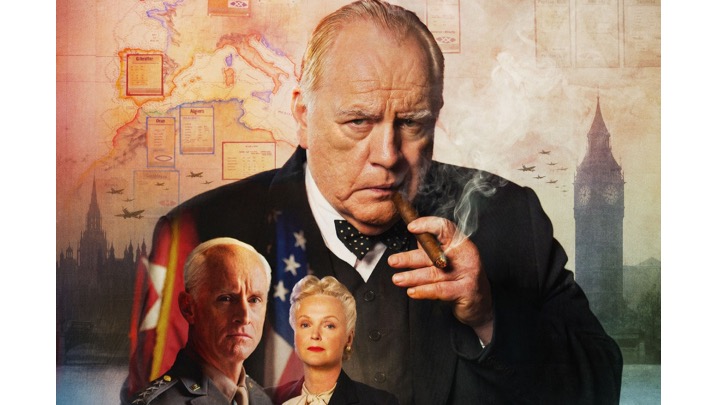“Churchill” – Steven Spielberg’s “Saving Private Ryan” (1998) reverberates in the halls of cinematic history as one of the greatest war films ever made. It effectively pays homage to soldiers – any soldiers – who risk their lives on the battlefield through the personal story of Capt. John Miller (Tom Hanks). Capt. Miller’s journey to bring Pvt. James Ryan (Matt Damon) home from the war is the true soul of the story, but the film is widely-known for its horrifyingly spectacular and technically iconic 23-minute vision of the D-Day invasion in June 1944. With large, menacing spikes littering Omaha Beach, the Allied Forces’ soldiers jump out of countless transport vessels into immediate gunfire, find land, crawl around barbed-wire netting, and attempt to overtake the Germans’ position. The sheer power of this jaw dropping sequence reminds us of the horrors of war and the bravery of these men.
“Churchill” is a movie about the D-Day invasion as well and told – obviously – from British Prime Minister Winston Churchill’s perspective. This is a very different war movie, but the words “personal” and “iconic”, along with the phrase “horrors of war” are completely valid in describing the themes in director Jonathan Teplitzky’s film.
The setting is 1,736 days into World War II. Churchill (Brian Cox) and the British people have been living with this conflict for five, long years, but American Gen. Dwight Eisenhower (John Slattery) – the commander of the Allied Forces – is just a few days away from launching Operation Overlord to hopefully overtake the German occupation of Western Europe.
Churchill – who has seen bloody, destructive war just 30 years earlier – disagrees with the mission due to the immense risk and opposes Eisenhower, but Senior British Commander Bernard Montgomery (Julian Wadham) sides with Ike. This leaves Churchill fighting a two-pronged war of his own between Eisenhower/Montgomery and his wife, Clementine (Miranda Richardson), who believes that he is meddling in places that he should not. In the meantime, he also attempts to convince King George VI (James Purefoy) to call off the invasion or at least change it substantially.
Churchill is a man of altruistic beliefs – granted, under a curmudgeon’s exterior – with the best intentions for British men who are “too young to be afraid”, but he is not. He knows the costs of war, and Teplitzky effectively communicates the ghosts from past conflicts, including an effective dream sequence in which Churchill stands on a British beach and helplessly watches bloody red ocean water roll at his feet.
Cox physically transforms into Churchill from his head to his feet and mesmerizes us in the process. As the United Kingdom’s beloved leader, he dresses in black with his signature hat and usually stews on a large, fat cigar. In the film, Cox portrays the man with an extremely strong sense of self and tenacity. Every word is layered with decades of vast political, military experience, filling every room with gravitas. Now, Churchill’s health was not grave in 1944, but he is clearly on the decline. At 69 years-old, he is heavy and balding and in frequent need of a cane and a handy glass of scotch. The film touches on Churchill’s battle with depression, but only lightly so. Teplitzky and Cox tread in this space for just a few minutes, but they address it with sincerity and care. Seventy-three years ago, one wonders how much was known about mental illness, and the film plays within these tones.
Speaking of tones, the film visually pays strict attention to its color palettes as dream sequences become understandably muted, while car trips to far away meetings feature the beautiful, lush English countryside as a pleasant and striking backdrop. A few times, Teplitzky pulls his camera back as Churchill, King George, Eisenhower, and others move like chess pieces on swathes of green. Not surprisingly, a chess match is in play.
This D-Day film does not drop the audience into action set pieces on a military front or beach, but lives in much smaller worlds where massive decisions are made. In dimly lit rooms with lingering cigarette smoke, titanic personalities argue and caucus about the potential outcomes of sending 250,000 men to French beaches. “Churchill” is a heady, conversational drama with one of modern history’s most recognizable heads of state at its center. Churchill may be the prime minister of an empire in which the sun never sets, but he – surprisingly – does not own the largest influence over Operation Overlord. Although Cox’s Churchill is determined to find a way, and the film transports us into history to watch how he worked.
In a movie with many intriguing moments, two truly stand out. One occurs in private, and the other is historically inspirational. Cox completely connects on both counts (and everywhere else over the 1-hour 38-minute runtime), as the film leaves its cinematic footprint, although much differently than “Saving Private Ryan”. I would not go as far to say that “Churchill” is a companion piece to Spielberg’s film, but it highlights the man’s presence during the war and his contributions towards peace.
⭐⭐⭐ out of ⭐⭐⭐⭐
Image credits: Cohen Media Group
YouTube credits: FilmTrailerZone




